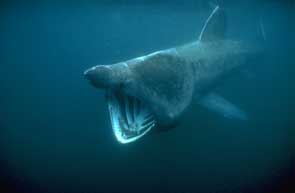
|
|
|
|
|
|
Shark Info (12-15-2000) |
Author |
|
Intro: |
Diving with large sharks - a foolish pastime or scientific necessity? |
Shark Info |
Main article: |
Diving with large sharks - a foolish pastime or scientific necessity? |
Dr. E. K. Ritter |
Article 1: |
Of what real advantage is the list of endangered shark species? |
Shark Info |
Article 2: |
Initiative to prohibit shark feedings off the coast of Florida rejected |
Richard Finkus |
Article 3: |
Shark Info |
|
Fact Sheet: |
Dr. E. K. Ritter |
|
Fact Sheet: Basking Sharks
Many biological aspects of the basking sharks are still a complete mystery. We do not know where the animals spend the cold season, and their gill rakers - a shedable filter structure in their mouths designed to strain plankton from the water - is a puzzle to scientists. Biology of basking sharks (Cetorhinus maximus)DescriptionThe basking shark's most important characteristics are its long gill slits which almost encircle the head and its pointed snout. Additional recognizable features are its lunate caudal fin and well-formed lateral keels. Size and AgeThe maximum size of these animals is approximately 10 meters. Reports on larger specimans have to date not been confirmed. Their maximum age is unknown, although efforts are being made to determine this by counting the number of vertebral spines/Wirbelringe (similar to the growth of tree trunks) and comparing them to the size of animals in known populations. FeedingBasking sharks belong to the few plankton eaters in the shark world. The only other filter-feeding species known to prefer plankton are whale sharks (Rhincodon typus, Fact Sheet Shark Info 3/00) and megamouth sharks (Megachasma pelagios, Fact Sheet Shark Info 1/99). Although other species such as the blue sharks (Prionace glauca) also have the necessary filter structure in the gill region which allows them to strain water and thus feed on plankton (krill) as their basic food, they only do this in rare cases. Called gill rakers, they are the main reason why basking sharks swim through the water almost permanently with wide open mouths. Compared to whale sharks, basking sharks are passive filterers, meaning they do not actively suck in water but rather let it flow in while swimming. ReproductionThis species' method of reproduction has not been widely researched. As with other representatives of the same group (white sharks, mackerel sharks, thresher sharks, etc.), they too bear living young, but the embryos are not connected by placenta to the mother (aplacental viviparous or ovoviviparous). The embryos nourish themselves by feeding on eggs produced by the mother (oophagy, the eating of eggs). Their size at birth is approximately 1.7 meters long. Based on counts made of the number of animals and their sex, the species appears to mate in schools prevailed by females. In addition they seem to have the longest gestation period of all sharks. DistributionThis species prefers cool and temperate waters and is distributed almost worldwide, although they appear to be limited to regions on the continental shelf. They are seen both in immediate proximity to the shore as well as in open waters. They also appear to be migratory, periodically appearing in certain places. Basking sharks can be found on the northern hemisphere off the coast of China, Korea and around Japan, on the East coast of the U.S., from Newfoundland down to Florida, around Great Britain and Norway, but also in the Mediterranean. In the southern hemisphere they are found primarily in Southern Australia, parts of South America and the tip of South Africa. BehaviorBasking sharks migrate mostly in schools, accordingly they also feed together. Their feeding behavior and migrations appear to be connected with the blooming of plankton. One theory is that when no plankton is available the animals periodically retreat to deeper regions where they shed their gill rakers. Based on this hypothesis the gill rakers are then regenerated by the time the next plankton blooms. Thanks to deposits of fat in their huge liver, they have no problem in overcoming this time period without plankton. Other theories say the animals who have shed their gill rakers do not fast when no plankton is available, but revert to feeding on organisms living on the ocean floor. More research will be necessary before these behavioral patterns are fully understood. Encounters with humansBasking sharks are harmless. Years ago the animals were hunted for their huge liver with its high content of Vitamin A and oil, the latter of which was used as lamp oil. Because of their very low reproduction rates and the strong pressure put on their populations by the fishing industry, these animals are today found on the IUCN list of endangered shark species. MythologyBasking sharks were the basis for many sea monster reports. They have a habit of swimming directly underneath the surface of the water ("basking" means to sun oneself or bask in the sun) and are frequently observed swimming in a row so that their dorsal fins and the upper lobes of their caudal fins penetrate the water, giving the impression that it is one huge animal. May be published only by indicating the source: Shark Info / Dr. Erich K. Ritter |
|
|
|
|
|
|||||
